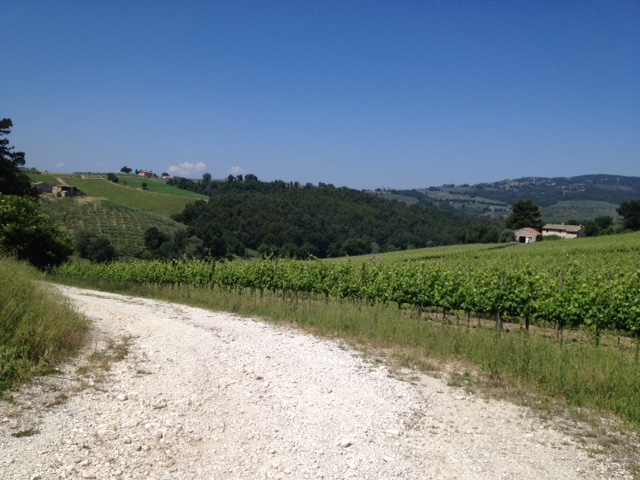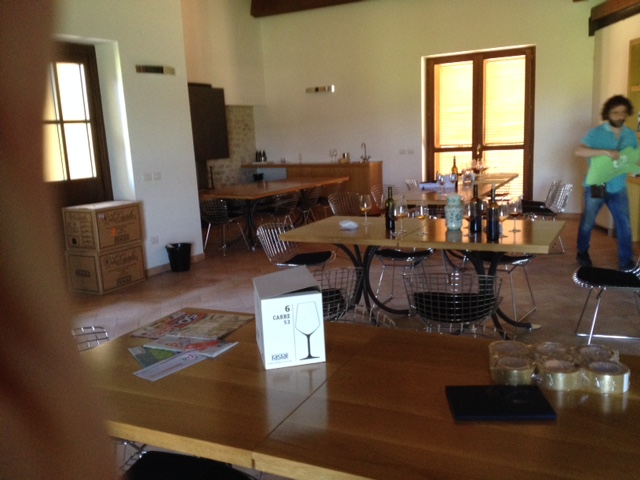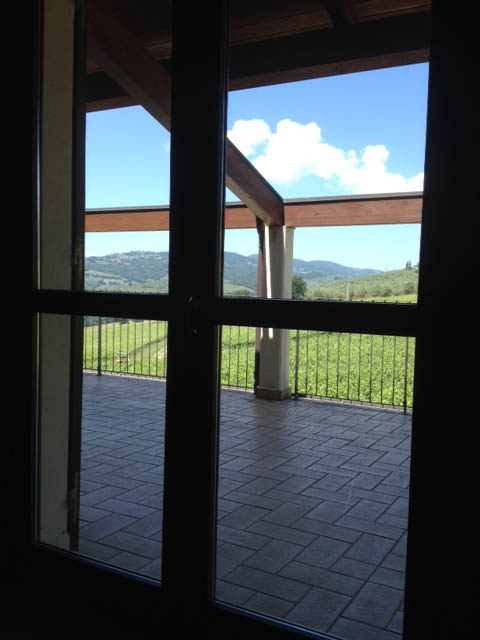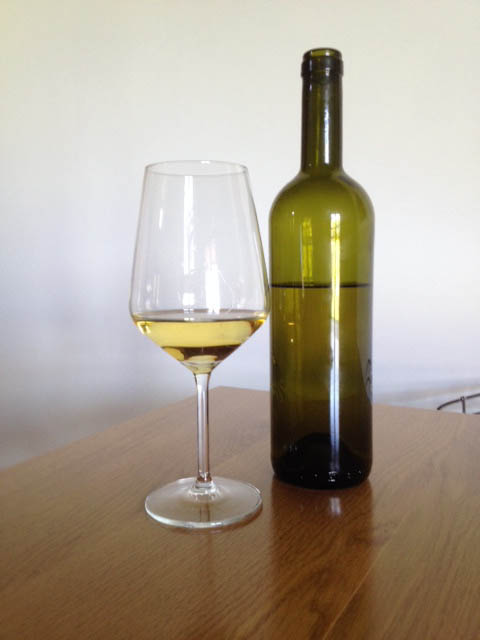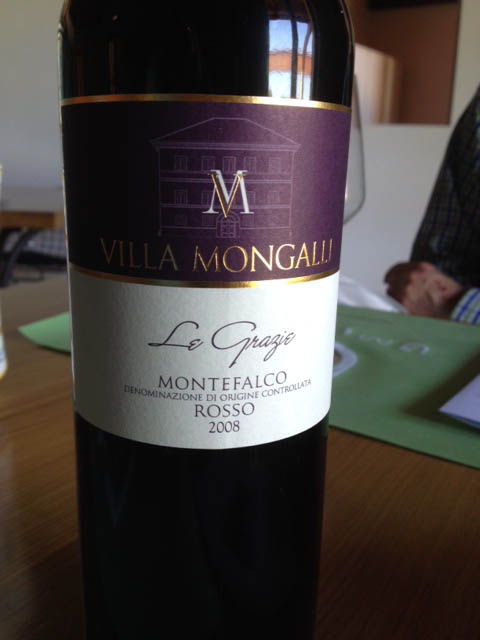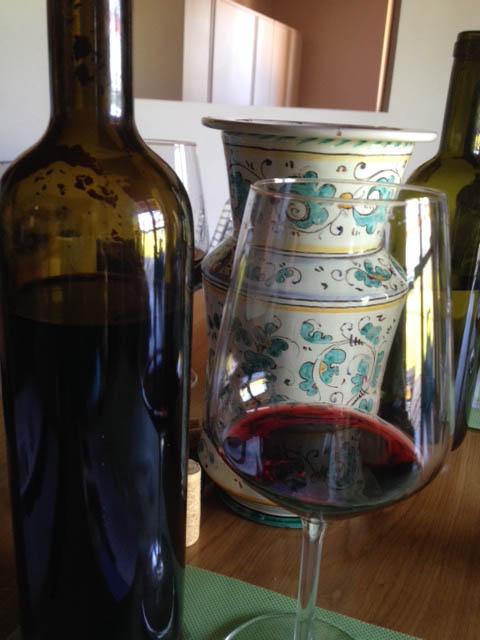 It’s a gorgeous day, as we head south along the E45, once the old Roman road, Via Flavia, which two thousand years ago connected Rome, on the western side of Italy, with Rimini on the Adriatic coast. Because the weather is particularly fine today, we remain on the E45 past Perugia towards Ripabianca. From here, we can put the top down and take a leisurely cruise along the SP415 through the countryside towards Montefalco and Bevagna, the land of Sagrantino. The SP415 follows a valley cut by a small creek past the lovely hill town of Gualdo Cataneo and ends just before the the unfortunatelly named town of Bastardo–yes, it means the same thing in Italian. We take the SS316 towards Montefalco and Bevagna and enter the Via del Sagrantino, the Sagrantino Road.
It’s a gorgeous day, as we head south along the E45, once the old Roman road, Via Flavia, which two thousand years ago connected Rome, on the western side of Italy, with Rimini on the Adriatic coast. Because the weather is particularly fine today, we remain on the E45 past Perugia towards Ripabianca. From here, we can put the top down and take a leisurely cruise along the SP415 through the countryside towards Montefalco and Bevagna, the land of Sagrantino. The SP415 follows a valley cut by a small creek past the lovely hill town of Gualdo Cataneo and ends just before the the unfortunatelly named town of Bastardo–yes, it means the same thing in Italian. We take the SS316 towards Montefalco and Bevagna and enter the Via del Sagrantino, the Sagrantino Road.
I’ve taken the precaution of going to the winery’s website and printing out a map. This turns out to have been a smart move, as the navigation system in the car seems convinced that the road we’re looking for does not exist. This is not unusual in Italian winery hunting as most of the wineries are truly in the middle of nowhere. We have discovered many interesting places while trying to find a place we’re interested in, if you’ll pardon that. Anyway, after a little looking, we find the correct road, which is, thankfully, paved. We follow it up a fairly steep incline to a hilltop amid the trees and go looking for the address I got from the website.
As we approach Villa Mongalli, we have our doubts, even though we know the address is correct. The winery, a wooden, barn-like structure, is framed by areas of unmown grass at least three feet high. A look around one side is both assuring and offputting; what is clearly a lovely deck with chairs and tables (winery!) had grass growing up to its floor. (out of business winery?) We might have left at that point, had we not seen a slightly opened door and two cars parked in front. Pretentious the place is definitely not.
Entering a large open unlit room, we again experience hopes and fears: Hope, because we are clearly in some sort of tasting room with medals and articles on the walls, tables and chairs, and stacks of wine guides and reviews. Fear, because it looks a bit like the aftermath of a fraternity party, with empty bottles and glasses on most of the tables.
From a smaller, better lit office area, a slightly built fellow with curly brown hair and intriguing grey eyes emerged and introduced himself as Pierpaolo Menghini. He and his brother Tommasso, who is also in the office, handle the everyday operation of the winery under the overall supervision of the father, who founded the operation. Pierpaolo is in charge of all things associated with making the wine; Tomasso handles sales, marketing and all things associated with the business. Pierpaolo throws open the curtains, revealing the deck we saw earlier, which presents a magnificent view of the rolling vineyards outside, gets glasses and finds a clear table. It’s tasting time.
Our tasting begins with Calicanto, Villa Mongalli’s Trebbiano Spolentino 2013. As you probably know, I am a big fan of this grape. But, for me it is still a very satisfying surprise. The wine is big and fat in the mouth, with a substance and character that I rarely find in most white wines. It is 100% Trebbiano Spolentino grown on an a 4.4 acre segment of the winery’s 33 acres. What was particularly interesting was that the wine opened up over time: something I associate only with reds. Pierpaolo sets some aside and twenty minutes we compare it with a freshly opened bottle. The difference is impressive. The wine seemed to gain depth and strength. This is, to date, the best Trebbiano Spolentino I’ve tried. [Nancy here: Pierpaolo was clearly VERY proud of this wine. I was stunned as the aroma of the wine drastically changed as it opened up over a period of over thirty minutes. Agree with the Wine Guy, I’ve never seen a white wine do this, only the reds. Amazing]
I noticed that many of the bottles we were tasting are unlabled. Welcome to Italy. Most of the wines made at Villa Mongalli are DOC or DOCG wines and receive the special DOC and DOCG label on the necks of the bottles. These labels are provided by the Government, which hasn’t gotten around to making them yet. Pierpaolo can’t run the bottles through the labelling machine twice, so he has to hold on to racks of unlabelled wine waiting for the labels. Ah well, as I’ve noted before: if you’re the impatient type, you better go to northern Europe. In Italy things get done when they get done.
Wine guy and Pierpaolo.

The rest of Villa Mongalli’s vines are red. We continue with the La Grazie 2010, which is a DOC Rosso di Montefalco. Unlike most Rosso di Montefalco’s, which tend to be 15% Sagrantino and 75% Sangiovese. At Villa Mongalli, the wine is 15% Sagrantino, 50% Sangiovese and the remainder a blend of Cabernet and Merlot which Pierpaolo adjusts each year to produce a balanced, ruby wine with plenty of fruit up front. A year in large oak barrels followed by a year on the rack give the wine backbone. I imagine you could lay it down for a while, but Pierpaolo considers it his “everyday” wine and I have to agree that it’s drinking fabulously right now.
Next, we passed to the main event, the Sagrantino. Villa Mongalli makes two Sagrantinos di Montefalco, Pozzo del Curato and Della Cima. The Pozzo del Curato is made from Sagrantino throughout the property, while the Della Cima (Italian for from the summit) comes from a 2 acre plot at the very top of the property that he points out to us from the deck. They are both prepared the same way, with three years in small oak barrels and a year in the bottle. With the air of a lion tamer demonstrating that he can keep the big cats under control, Pierpaolo pours the wines out. We let them breath for about ten minutes–always an excellent idea with Sagrantino–and taste. These are monsters. The wine is intensely ruby to purple, bursting with fruit and spices. We are drinking the 2005 vintage, but the tannic basis is still there. I daresay this wine could easily go another ten years. Pierpaolo thinks that the Della Cima has a bit more elegance and aging potential–it’s slightly more alcoholic at 14,5% as opposed to 14.0% for the Pozzo del Curato. It is hard to tell for sure. They are both fabulous. He calls these “occasion wines” and I have to agree. These are wines that are too commanding to drink as accompaniments to food. They deserve to be enjoyed by themselves. Perhaps chocolate, or very powerful cheese might work, but I think the wine demands your attention. Think port without the sweetness.
Finally, we come to Pierpaolo’s surprise wine, the Col Cimino 2005. This is Pierpaolo’s single non-traditional wine, which he says is particularly loved by “the Anglo-Saxons”. It is a wine of equal parts Sangrantino, Cabernet and Merlot with three years of barrel age and, to me, it resembles a fine Bordeaux (please don’t tell the French I said this) with the tannins of the Sagrantino and Cabernet giving the wine a solid structure and the fruitiness of the Sagrantino and Merlot offsetting the more closed character of the Cabernet. We find it very satisfying. I’m not sure how much farther the 2005 can go, perhaps a few years, but I would say it is near perfect right now. Don’t expect any fancy labels on this wine. Because it’s not produced according to the DOC/DOCG standards it is labelled a humble IGT Rosso Umbria. It is most definitely a diamond in the rough.
After loading the car to bursting with wine, we asked if we could buy a bottle of wine and drink it with the picnic lunch we brought with us. “No problem” was the answer, and Pierpaolo fetched us a chilled bottle of Trebbiano Spoletino from the cellar. He than asked us if we’d like to take the bottles we had been tasting, most of which were not close to empty, with us! We gathered as many as we felt we could without looking too greedy. It was unbelievable.
Our table littered with half empty bottles.
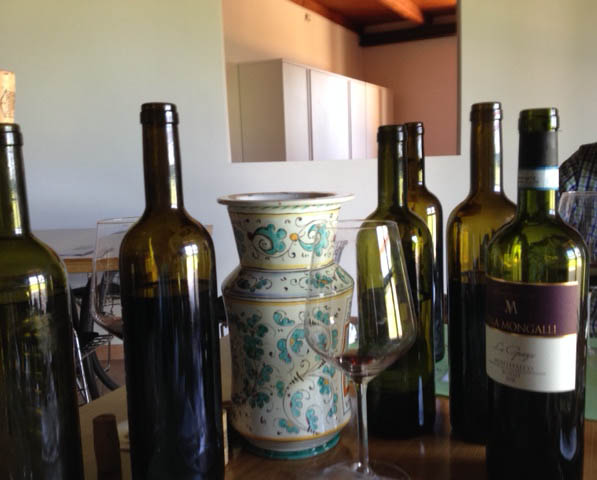
Our simple picnic of proscuitto crudo, pecorino cheeses and bread.
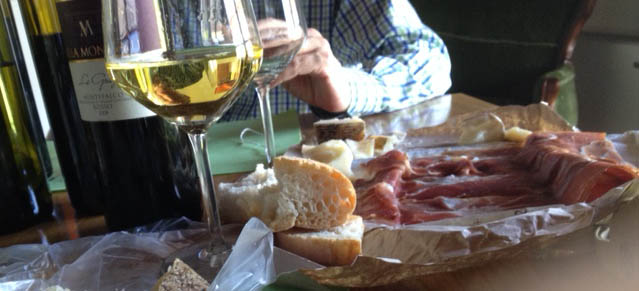
For folks who are interested in this sort of thing, Via Mongalli exports solely to the Bay area in California. If you live there, lucky you. If not, it is an excellent excuse to take a jaunt to Umbria. On balance, Villa Mongalli is one of the best wineries we’ve visited here in Umbria.

